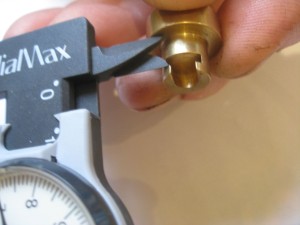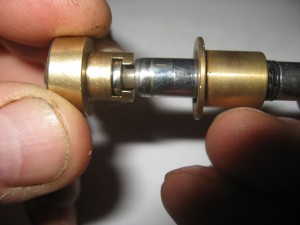Cameron SB23 Lindstrand valve stem modification – Updated 04.03.18.
Please note that this SB has gone to SB23 Rev 2 part of which is a Highly Recommended annual/100hr strip and inspection of the affected parts. If this ever becomes an EASA Airworthiness Directive it will make replacing the stems preferable to the cost of an annual strip and inspection. Squeeze action valves are not affected by the SB (and probably not by any EASA AD) but all toggle action valves, both whisper and main are. In the event the SB still remains as Highly Recommended.
 Having now stripped down numerous valve assemblies and found no appreciable wear whatsoever (based on the difference between measurements taken from original Lindstrand unused seat carries and the ones removed) we have now modified our advice to owners. Please note that wear will be in the form of an indentation inside the carrier matching the tab on the end of the valve stem. Taking an accurate measurement is tricky at best. Wear is the difference between the outer edge as shown and any internal indentation.
Having now stripped down numerous valve assemblies and found no appreciable wear whatsoever (based on the difference between measurements taken from original Lindstrand unused seat carries and the ones removed) we have now modified our advice to owners. Please note that wear will be in the form of an indentation inside the carrier matching the tab on the end of the valve stem. Taking an accurate measurement is tricky at best. Wear is the difference between the outer edge as shown and any internal indentation.
As the Service Bulletin is Highly Recommended and not Mandatory we would suggest that having now inspected many assemblies, and had feed back from others, that there is very little possibility of failure through excessive wear. As it is not practically possible to measure the wear as specified in the Accomplishment Instructions accurately and close visual inspection has shown no detectable ridging, we have compared the measurement between the underside of the seat carrier and the return under the top of the slot between the old and new components. Nominally we found the two Lindstrand carriers as supplied new we had in stock measured 6.85mm between these points. Don’t necessarily take our measurement as gospel but its as near as we could get and as this is a comparison the difference is the key rather than the specific measurement, but this is still tricky.
On the first burner we found measurements of 6.85, 6.95, 6.90 and 6.85. There was no evidence of recent replacement however the bonnets showed evidence of having been removed at least once in the past. The second burner produced measurements of 6.85, 6.90, 6.85 and 6.95. One of the seat carriers had very little wear to the seat so it can be assumed that it was replaced recently. As with the first burner all the bonnets showed signs of having been removed at least once. It is difficult to estimate the hours these burners have done but in both cases it is certainly in excess of 250. The maximum wear we measured was 0.1mm well below the requirement.
Similar results were found in the other two one of which was a very early burner. Of these one had Mod C650 applied at the request of the owner but the other did not, however all seals, including the seat carriers, were replaced. As you would expect there was no wear to the any of the valve spindle nipples. With the valve spindle nipple engaged in the seat carrier slot and the collar fitted it was virtually impossible to discern any difference in vertical free play (end float) between the carrier and valve spindle. As is probably to be expected the only discernable wear was in the main valves with the right hand one with the pilot light valve up being the favoured one apart from the third burner which had had seals replaced recently on that particular assembly.
We have checked back through our records and found that in most cases the Lindstrand valve assemblies required the replacement of the seals through leaks, sticking or lack of lubrication at around 200-300 hours. In all cases we replaced the copper washer, quad seal, spring seal, the seat carrier and occasionally the friction washer on the top as these are sometimes prone to swell and prevent the valve stem from operating correctly. We do not recall any undue vertical wear being noticed in the seat carrier body. We do not think that the affected part would fail through wear ahead of any of the seals.
Following our findings and our experience of working with, and repairing, the Lindstrand burners we now recommend that unless there is a problem with a sticking valve or leak necessitating stripping down then no action is needed. If such action is required we would suggest that perhaps at that time the stem assemblies incorporating the Mod are fitted as you would already be replacing the seals including the seat carrier and although failure is extremely unlikely the modified stem offers that extra bit of protection and, of course, covers that ‘if it can it will’ ethos. There would be no difference in the time it would take to effect the repair whether or not the stem was replaced. The additional cost would only be that of the stem itself.
If you do dismantle the bonnets and replace the seals it is important that the copper washer is replaced and the faces cleaned. In some cases you will have to carefully clean the threads of both the bonnet and burner block. It is prudent to take measures prior to this to prevent particles falling into the exposed threaded housing in the block. Following assembly great care must be taken to check for leaks between the bonnet and block. Such leaks can be extremely small and difficult to detect.